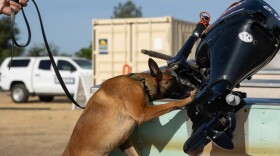Jack Murray watched the Sept. 11 disaster unfold from the roof of his Manhattan apartment building. A welder by trade, he found his way to ground zero, where he cut steel beams so that rescue workers could search for survivors.
"I can certainly say, if you were going to find somebody that day to go down there who was pragmatic and clearheaded, I was not that guy," Murray says. "I honestly thought that the world was going to come to an end."
But after going to the neighborhood bar to see what people were doing, he agreed to go down to the site with a friend who had construction experience.
"Later on that first night, I had this thought that I was standing on this gigantic funeral pyre going into the earth. ... I realized I was probably breathing in the ashen remains of some of the people," Murray says. "It was kind of like a communion for me."
Murray, now 45, continued working at ground zero for two weeks after he first arrived the night of Sept. 11.
John Romanowich, 63, spent four months at ground zero. He was working for the Department of Design and Construction, the city agency in charge of the cleanup. He says initially stepping off the bus at the site felt "like we crossed into a different reality."
He worked from 3 p.m. to 11 p.m. or midnight, preventing him from routinely seeing his wife and daughter. One morning he woke up to find his identification for access to ground zero was gone. His daughter had taken it to school. She later told him that she took it out of pride to show her friends.
"I think most of us considered ourselves just to be ants crawling around on the pile. But in her eyes, I was a big deal -- I was going to ground zero every day," Romanowich says.
He worked at the World Trade Center site from mid-September to mid-January. He says returning to a normal schedule was difficult.
"We never felt right when we had to leave, when we had to go home. So that was like you were getting cut from the team."
Romanowich retired from the Department of Design and Construction in 2009.
Produced for Morning Edition by Jasmyn Belcher and Michael Garofalo.
Copyright 2022 NPR. To see more, visit https://www.npr.org. 9(MDAzMjM2NDYzMDEyMzc1Njk5NjAxNzY3OQ001))





